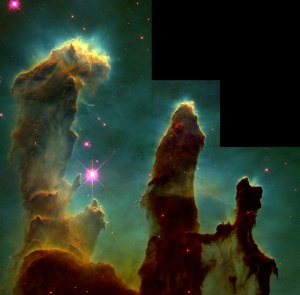Revealing protostars and giant clouds of gas and dust where new stars were born

Image Credit: European Southern Observatory
Space news (August 18, 2015) – 7,000 light-years away toward constellation Serpens (The Serpent); the iconic Pillars of Creation
Astronomers working with the Multi Unit Spectroscopic Explorer (MUSE) on the European Southern Observatory’s (ESO) Very Large Telescope (VLT) have released the first 3D image of the Pillars of Creation in the Eagle Nebula (M16 or Messier 16).

The Pillars of Creation are a stellar feature that is more common than people first assume. Similar structures and shapes have been and are quite frequently seen during the human journey to the beginning of space and time. The columns of the Pillars of Creation were formed when intense radiation and stellar winds from huge, newly formed blue-white O and B suns blew away less dense material in the region of space surrounding them.
A study has shown the very top of the left pillar in the image is pointing toward us and sitting on top of another pillar behind nearby stellar cluster NGC 6611. This top portion of the left pillar is bearing the majority of withering radiation from nearby stars and this is why it looks brighter to our eyes compared to the other pillars.
“I’m impressed by how transitory these structures are. They are actively being ablated away before our very eyes. The ghostly bluish haze around the dense edges of the pillars is material getting heated up and evaporating away into space. We have caught these pillars at a very unique and short-lived moment in their evolution,” explained Paul Scowen of Arizona State University in Tempe. He and astronomer Jeff Hester, formerly of Arizona State University, led the original Hubble observations of the Eagle Nebula.
Scowen said. “The gas is not being passively heated up and gently wafting away into space. The gaseous pillars are actually getting ionized, a process by which electrons are stripped off of atoms, and heated up by radiation from the massive stars. And then they are being eroded by the stars’ strong winds and a barrage of charged particles, which are literally sandblasting away the tops of these pillars.”
The denser material left behind acted as a shield against the harsh, withering glare of nearby brilliant young stars, and formed the shape of the region. The dark “tails” or “elephant trunks” viewed as the dark body of the pillars point away from the intense radiation and stellar winds of nearby brilliant stars.
Now, astronomers plan on studying how newborn O and B stars in NGC 6611 influence the growth of further generations of stars. Previous studies have detected protostars forming within the clouds of NGC 6611. The latest study also provided evidence for protostars forming in the middle and left clouds of the Pillars of Creation and there are also probably other protostars and young stars hidden from view within the region.
Astronomers want to study star-forming regions like the Pillars of Creation in order to better understand the conditions in which stars like our own Sun formed. Current evidence points to the early solar system being bombarded with radioactive shrapnel from a nearby supernova. This indicates we formed in a star-forming region with young stars massive enough to produce powerful ionizing radiation like we see in the Eagle Nebula.
“That’s the only way the nebula from which the sun was born could have been exposed to a supernova that quickly, in the short period of time that represents, because supernovae only come from massive stars, and those stars only live a few tens of millions of years,” Scowen explained. “What that means is when you look at the environment of the Eagle Nebula or other star-forming regions, you’re looking at exactly the kind of nascent environment that our sun formed in.”
You can find out more about the MUSE here.
Learn more about the European Southern Observatory here.
Discover more about the Hubble Space Telescope and the things we have discovered here.
Learn more about the formation of stars here.
Read about the surprises planetary scientists discovered during the recent flyby of NASA’s New Horizons spacecraft.
Learn more about how exploding stars seed the universe with the building blocks of life.
